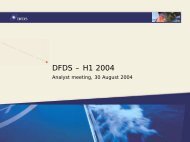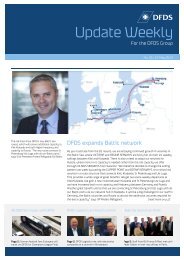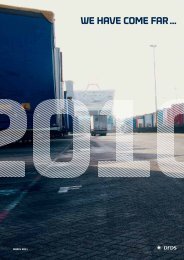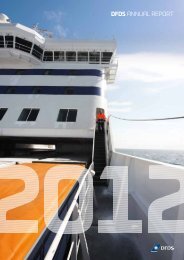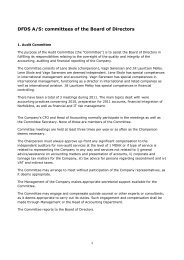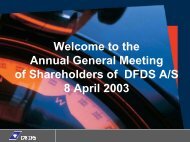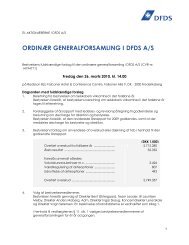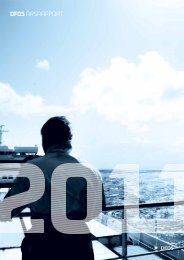English - DFDS
English - DFDS
English - DFDS
You also want an ePaper? Increase the reach of your titles
YUMPU automatically turns print PDFs into web optimized ePapers that Google loves.
20 RO-ro shipping<br />
<strong>DFDS</strong> annual report 2009<br />
Markets, activities and customers<br />
Ro-Ro Shipping’s activities comprise the operation of route networks<br />
on the North Sea and the southern half of the Baltic Sea. On<br />
the North Sea, primarily the flow of goods between Scandinavia<br />
and Great Britain/the Continent, as well as between the Continent<br />
and Great Britain, are serviced. In the Baltic Sea, services are mainly<br />
focused on the flow of goods between Scandinavia and the Continent<br />
on the one hand, and Russia, the Baltic States and the CIS countries<br />
on the other.<br />
The network includes ro-ro and ro-pax routes, the latter primarily<br />
in the Baltic, where the market for unaccompanied trailers is larger<br />
than on the North Sea.<br />
International haulage and forwarding companies account for approximately<br />
56 % of total volumes, manufacturers of heavy industrial<br />
goods approximately 44 %. This split remained unchanged from 2008.<br />
The most important industrial target customer groups are the car<br />
industry and producers of heavy goods and plant equipment requiring<br />
development of tailor-made logistics systems, including investment in<br />
specialised transport equipment, IT solutions, dedicated warehouses<br />
and, in some cases, deployment of larger tonnage. Industrial logistics<br />
contracts are therefore long-term with <strong>DFDS</strong> operating as part of the<br />
customer’s supply chain.<br />
Market trends<br />
The Northern European ro-ro freight market as a whole declined by<br />
about 10 % in 2009 as a result of the recession, which began in late<br />
2008. The total decline in <strong>DFDS</strong>’ primary markets in the southern<br />
Baltic Sea and the North Sea was around 15 %. The largest decrease<br />
was experienced in H1 2009, particularly Q1. The market stabilised<br />
in H2, and in Q4 volumes reached a level at or above Q4 2008 in<br />
several market areas.<br />
The low level of activity created overcapacity in most companies<br />
in the ro-ro sector, as well as among container and trailer operators,<br />
impacting rate levels negatively. The competitive situation, especially<br />
in the Baltic Sea, was characterised by overcapacity in the land-based<br />
transport sector. However, in response to the market conditions,<br />
several shipping companies adapted capacity by closing routes and by<br />
chartering out and laying up tonnage.<br />
Ro-Ro Shipping’s success criteria<br />
The most important success criteria for Ro-Ro Shipping are reliability<br />
and frequency and a schedule adapted to customers’ requirements.<br />
Other significant factors include adjusting capacity to reflect market<br />
trends, and reducing clients’ overall transport time on an ongoing basis,<br />
which places demands on tonnage speed and turnaround time in port.<br />
Fleet modernisation and adaptation<br />
The fleet was further modernised in 2009 following the deployment<br />
of two newer ro-ro ships on the route between Rotterdam and<br />
Immingham at the start of the year, and a ro-pax newbuilding on the<br />
route between Kiel and Klaipeda in May 2009. Customer service has<br />
been improved on both routes through increased reliability, frequency<br />
and capacity.<br />
In addition, the third in a series of four chartered ro-ro newbuildings<br />
was delivered in mid-2009. By the end of 2009, three older<br />
chartered ro-ro ships had been returned, and the fleet’s oldest ro-ro<br />
ship was sold in early 2010.<br />
In mid-2009, three ro-ro ships sailing between Sweden and England<br />
were extended, which reduces operating costs and environmental<br />
impact per unit, and adds capacity to the market.<br />
The renewal of tonnage in 2008 and 2009 led to savings in terms<br />
of both operating costs, including bunker consumption, and improved<br />
operational reliability, strengthening the route network’s long-term<br />
competitiveness. It is therefore currently estimated that no tonnage<br />
investments are required within the next couple of years.<br />
The tonnage market<br />
The global decline in activity generated overcapacity in the market for<br />
ro-ro and ro-pax tonnage, particularly for older and smaller tonnage.<br />
Older ships still constitute a disproportionately large share of global<br />
ro-ro tonnage, and rates for newer and larger tonnage are therefore<br />
expected to remain relatively stable over the coming years. This is also<br />
based on a moderate influx of new tonnage, as capacity on orders<br />
constituted approximately 15 % of global capacity at the end of 2009.<br />
In addition, the number of ships scrapped is expected to rise in 2010<br />
and new orders very limited.<br />
Ro-Ro Shipping 2008 2009<br />
DKK miLLION Q1 Q2 Q3 Q4 FULL YEAR Q1 Q2 Q3 Q4 FULL YEAR<br />
Revenue 926 997 1,009 867 3,799 669 736 798 794 2,997<br />
Operating profit before depreciation<br />
(EBITDA) 186 217 207 174 784 119 135 132 133 519<br />
Profit/loss on disposal of tangible assets 0 7 3 2 12 0 0 0 0 0<br />
Depreciation -62 -65 -66 -53 -246 -63 -69 -73 -82 -287<br />
Operating profit (EBIT) 124 159 144 123 550 56 66 59 51 232<br />
Operating profit margin (EBIT), % 13.4 15.9 14.3 14.2 14.5 8.4 9.0 7.4 6.4 7.7<br />
Invested capital, average 4,596 4,645 4,626 4,491 4,560 4,510 4,916 5,256 5,320 4.965<br />
Return on invested capital (ROIC) p.a., % 10.8 11.9 12.2 10.7 11.7 4.7 5.0 4.4 3.6 4.4<br />
Lanemetres, '000 2,605 2,663 2,474 2,269 10,017 2,139 2,274 2,327 2,457 9,197<br />
Passengers (Baltic Sea), '000 45 58 81 40 224 63 94 129 77 363



